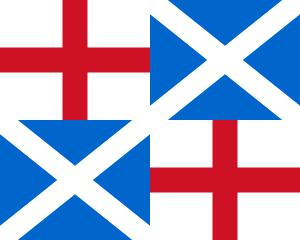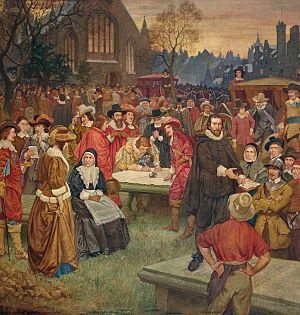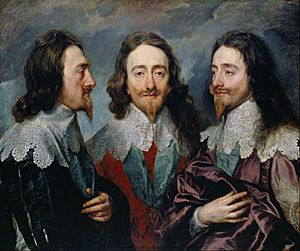Outline of the wars of the Three Kingdoms facts for kids
The Wars of the Three Kingdoms were a series of big fights that happened in England, Ireland, and Scotland between 1639 and 1651. These wars were all connected and changed how these kingdoms were ruled.
Contents
Why the Wars Started
Several things led to these wars:
- King Charles I's Personal Rule: From 1629 to 1640, King Charles I ruled without calling Parliament. This made many people in England unhappy because they felt the King was taking too much power.
- Jenny Geddes' Protest: In 1637, a woman named Jenny Geddes started a riot in Edinburgh, Scotland. This happened because people were angry about King Charles I trying to make the Church of Scotland use a new prayer book, the Book of Common Prayer.
- The National Covenant: In 1638, many Scots signed the National Covenant. This was a promise to defend the Church of Scotland from the King's changes. It showed how strongly people felt about their religion and their right to choose how their church was run.
Who Fought in the Wars
The Wars of the Three Kingdoms involved several different groups:
- Royalists: These were people loyal to King Charles I and later his son, Charles II of England. They believed the King should have supreme power.
- Covenanters: These were Scottish Presbyterians. They were organized by the Church of Scotland and fought to protect their religious freedom and church structure.
- Confederate Ireland: From 1642 to 1649, this group of Irish Catholics managed to rule themselves for a while. They often allied with the Royalists.
- Parliamentarians: Also known as Roundheads, these forces fought to give Parliament more power than the King. They believed Parliament should have the final say in how the country was run.
Important Governing Groups
Different groups tried to govern during these wars:
- Long Parliament: This was the Parliament of England that met from 1640 to 1660. It played a huge role in challenging the King's power.
- Committee of Estates: This group governed Scotland during the war.
- Oxford Parliament: King Charles I set up his own Parliament in Oxford in 1644 to support his war efforts against the main Parliament.
Main Conflicts of the Wars
The Wars of the Three Kingdoms included several major conflicts:
- Bishops' Wars: These were two short wars in 1639 and 1640. They were fought over how the Church of Scotland should be governed, specifically about the King's attempts to change it.
- Irish Confederate Wars: This long conflict in Ireland lasted from 1641 to 1653.
- Irish Rebellion of 1641: This was a big uprising by Irish Catholics against English rule.
- Cromwellian Conquest of Ireland: From 1649 to 1653, Oliver Cromwell led an invasion of Ireland, which was very brutal.
- English Civil Wars: These were a series of fights over who should rule England. Soldiers from Scotland and Ireland also took part.
- First English Civil War: This lasted from 1642 to 1646.
- Second English Civil War: This was a shorter conflict in 1648.
- Third English Civil War: This took place from 1649 to 1651.
Key Events During the Wars
Besides the battles, some important non-military events happened:
- Short Parliament: In 1640, King Charles I called Parliament, but he dissolved it after only three weeks because they wouldn't agree with him.
- Treaty of Ripon: In 1640, this agreement forced King Charles I to give parts of England (Northumberland and County Durham) to the Scottish Covenanters. This made him call Parliament again, which led to the Long Parliament.
- Grand Remonstrance: In 1641, Parliament gave King Charles I a long list of complaints about his rule.
- Solemn League and Covenant: In 1643, Scottish Covenanters and English Parliamentarians made an agreement to work together against the King.
- Execution of Charles I: In 1649, King Charles I was put to death. This was a shocking event, as it was the first time an English king had been executed by his own people.
Important People in the Wars
Political Leaders
- King Charles I: The King of England, Scotland, and Ireland from 1625 until his execution in 1649. His conflicts with Parliament led to the wars.
- King Charles II: Son of Charles I. He was King of Scotland from 1649 to 1651 and later became King of all three kingdoms in 1660.
- John Pym: A powerful leader in Parliament who strongly opposed the King.
- Archibald Campbell, 1st Marquess of Argyll: He was basically the head of the Scottish government for most of this period.
Military Leaders
- Oliver Cromwell: A very successful general in the Parliamentarian army. He later became a very powerful leader in England.
- Thomas Fairfax: The main commander of the Parliamentarian army.
- Alexander Leslie, 1st Earl of Leven: A key commander for the Scottish Covenanters.
- James Graham, 1st Marquess of Montrose: He first fought for the Scottish Covenanters but later became a Royalist commander for King Charles I.
- Prince Rupert of the Rhine: A skilled commander for the Royalist army and the King's nephew.
Other Notable People
- Jenny Geddes: A woman whose protest in Edinburgh helped start the Bishops' Wars.
What Happened After the Wars

Flag of the Commonwealth. This flag was used when England was a republic.
The Wars of the Three Kingdoms had big consequences:
- Commonwealth of England: After King Charles I was executed in 1649, England became a republic, meaning it was ruled without a king.
- Interregnum: This was the period from 1649 to 1660 when England, Scotland, and Ireland were ruled as a republic, without a monarch. It ended when Charles II of England became King.
See also
- European wars of religion
- Thirty Years' War
- Timeline of the Wars of the Three Kingdoms

All content from Kiddle encyclopedia articles (including the article images and facts) can be freely used under Attribution-ShareAlike license, unless stated otherwise. Cite this article:
Outline of the wars of the Three Kingdoms Facts for Kids. Kiddle Encyclopedia.



